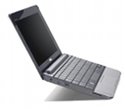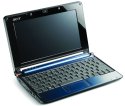Canonical disputes Microsoft netbook claims
Apr 9, 2009 — by Eric Brown — from the LinuxDevices Archive — 2 views Ubuntu sponsor Canonical has posted a blog entry disputing Microsoft's claims that it owns 96 percent of the netbook market, and that Linux netbook returns are four times higher than with Windows. Canonical was responding to a blog earlier this month from Microsoft's Brandon Le Blanc.
Ubuntu sponsor Canonical has posted a blog entry disputing Microsoft's claims that it owns 96 percent of the netbook market, and that Linux netbook returns are four times higher than with Windows. Canonical was responding to a blog earlier this month from Microsoft's Brandon Le Blanc.
Written by Chris Kenyon from Canonical's OEM Services, the blog post, “Microsoft, FUD and the netbook market,” claims that Microsoft's Le Blanc was incorrect when he wrote that Canonical confirmed a 4x return of Ubuntu-based netbooks (such as the Dell Inspiron Mini 10 pictured above), compared to returns of Windows XP-based netbooks. In fact, Kenyon writes, “well-engineered Linux netbooks have similar return rates to XP.” As for the 96 percent claim, he responds that “when customers are offered choice on equally well-engineered computers, around a third will select Ubuntu over XP.”
 MSI Wind (Click for details) |
Le Blanc's claim on return rates appears to be based on an October Laptop Magazine story that quoted an MSI executive as saying that returns of its Linux-based MSI Wind netbooks were more than four times higher than those of Windows XP netbooks. As we noted at the time, the MSI claim was interesting in that MSI had not actually shipped the Linux version of the Wind, which was set to run an enterprise desktop-focused SUSE Linux distro. In fact, the claim may have been based on earlier MSI notebooks that ran Linux. Also, the executive was quoted as saying that his general impression about Linux returns was based in part on discussing the subject with a retailer of Asus netbooks, not from Asus itself.
It is unclear where Le Blanc's apparently mistaken claims about similar return rates for Ubuntu-based netbooks derived. Kenyon seems to suggest it is simply another case of Microsoft FUD.
LeBlanc's claim that Microsoft Windows products, primarily Windows XP, run on 96 percent of netbooks might have been based on December 2008 through February 2009 numbers cited by the NPD Retail Tracking Service. While it does appear to be true that Windows XP has been gaining market share in recent months over Linux, the NPD numbers track in-store sales from brick-and-mortar retail stores, where Linux options are often not available, and do not appear to cover online sales. What's more, the NPD numbers only cover U.S. sales, where Windows predominates, while Linux is more popular in Europe and elsewhere.
 Acer Aspire One: the netbook market leader (Click for details) |
If Le Blanc's 96 percent claim is true, it would represent a phenomenal turnaround for Windows. In November, Bloomberg.com reported that Linux gains in netbooks were hurting Microsoft's bottom line, and quoted Microsoft as estimating that Windows products run on about 70 percent of netbooks. The story also quoted an Asus exec as saying that Linux had shipped in 30 to 40 percent of its Eee PCs, and that it expected Linux models to sustain a 30 percent rate going forward. Asus expected to sell 5 million Eee PCs in 2008, said the story, whereas Acer was said to have predicted sales of 5 million to 6 million Aspire One netbooks (pictured), with about 20 percent offering Linux. At the time, we estimated from various reports that Linux might represent about a quarter of the netbook market.
Despite the limitations of the NPD report, other anecdotal evidence, as well as a new study by Ovum, appears to suggest a slippage in Linux netbook market share. Ovum did not publicly report exact percentages, but reported that the Linux netbook share has dropped considerably in recent months. (However, when it said that, despite the trend toward Windows XP, “Linux's performance in the netbook segment is still outstanding compared to its overall performance in the desktop market,” it would suggest that the Linux market share is probably higher than four percent.) If nothing else, the fact that leading netbook vendors, such as Asus and Acer have recently been announcing high-end netbook models without Linux installs, at least in the U.S., would suggest that the Windows shift is real.
Reasons for the falling share of Linux netbooks may include:
- Growing market — Linux jumped out early with netbooks when Microsoft was looking the other way. Now that Microsoft is interested in the hot-selling devices, it has enormous marketing clout in ensuring that major brands run Windows XP (and eventually Windows 7). As the NPD study reports, “nearly 50 percent of all netbook sales for 2008 occurred in December.” In other words, because Linux was first to the market, its early 25-30 percent share may have been illusory, especially considering that its overall desktop share was pegged recently by Net Applications to be under one percent. With Microsoft recently pushing Windows XP netbooks among hardware partners and retailers, Linux share was bound to go down. Many of the me-too netbooks of late 2008 came from vendors who never install Linux on their computers.
- More affordable XP — As Kenyon notes, Linux competition led Microsoft to deeply discount Windows XP last year, so pricing is no longer such an overwhelming Linux advantage.
- Familiarity — Consumers are more comfortable with the familiar Windows XP than they are with Linux. This is also one reason why they have been hesitant to switch to Vista. With all its quirks, Windows XP, which Microsoft was ready to abandon until the netbook craze hit, is affordable and mature.
- User friendliness — Windows installs for netbooks are almost all Windows XP, whereas Linux installs represent a variety of distros, some of which, like SUSE Linux, have not been optimized for the constrained world of the netbook, nor even for consumers. The rise of consumer friendly distros like Ubuntu is changing the game, but even Ubuntu has a way to go.
- Peripheral support — Consumers still tend to believe that Windows offers far greater peripheral and software support, and do not want to limit their choices with Linux. Compatibility has always been the conversation stopper when it came to the Linux (or Mac) vs. Windows argument, as it could always be argued that Windows offers support for more peripherals and software. Yet, this is true to a lesser degree each year, especially with device support. When Le Blanc claims that Windows supports “3,000 printers, more than 700 digital cameras, more than 240 webcams, and more than 180 digital video cameras,” Kenyon replies that “Ubuntu and most Linux distributions support over 3000 printers, over 1000 digital cameras, and over 200 webcams.”
- Software support — Windows still has the edge with software, but most categories are covered by increasingly mature Linux software, with more and more alternative choices available. In any case, netbooks are designed primarily for Web browsing and basic apps, so software variety is not nearly as important. As Kenyon notes, with established, user-friendly brands like Firefox and OpenOffice available for Linux, as long as the distro offers essential Web-browsing components like Adobe Flash and basic media codecs, netbook consumers tend to be satisfied.
Looking forward, there are several reason to believe that Linux might at least start to regain some of its early market share if not increase it. These include:
- Growing awareness of Linux — Consumer recognition of Linux's existing strengths in anti-virus protection, fast boot times, and for some users, modifiable, open source software, is likely to grow.
- Improving Linux — Increasingly user friendly Linux distributions, including a new Moblin v2 for Netbooks, and more and more software and peripheral support should eventually get noticed.

Always Innovating's
ARM Cortex-based Touch Book
(Click for details) - Android — HP, Asus, Acer, and others are evaluating the Linux-based, Google-sponsored Android as a potential netbook OS with consumer appeal. Ovum, which like NPD, also noted a swing towards Windows XP in netbooks, believes that Linux can ride back to prominence in the segment with Android running on sub-$200 netbooks. According to recent reports, Acer is pushing forward with its Android smartphone, but believes that Android is not yet ready for netbooks. On the other hand, the same Acer executive who was said to be skeptical of Android (Senior VP Jim Wong), was quoted as saying he had similar reservations about the upcoming Windows 7.
- ARM appeal — The ARM-based netbooks are coming, most based on Cortex-A8-based system-on-chips like the Texas Instruments OMAP3x and the Freescale i.MX515, and Cortex-A8-like Qualcomm Snapdragon. The vast majority are likely to run Linux, and at least initially won't run Windows, and will also offer clear-cut advantages over the Intel Atom and other x86 processors on battery life and fast boot-up, two of the keys to netbook success.
Availability
Kenyon's Canonical blog may be found here, and Le Blanc's Windows Experience blog may be found here.
Linux-based netbooks are NOT so likely to be found at your local computer retailer, but they're out there.
This article was originally published on LinuxDevices.com and has been donated to the open source community by QuinStreet Inc. Please visit LinuxToday.com for up-to-date news and articles about Linux and open source.